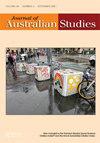Class Acts: TV Larrikins and the Advent of the Ocker, 1957–1984
IF 0.4
3区 历史学
Q3 AREA STUDIES
引用次数: 0
Abstract
ABSTRACT Stephen Fry has described the typical American comic hero as a freewheeling “wisecracker” compared to the English type, who is apt to be an aspirational lower-middle-class failure. With Fry as a prompt, we consider humour and class in the evolution—or devolution—of that representative local hero, the larrikin, during Australian television’s first three decades. This was a period that saw a realignment of the nation’s political, economic and cultural affiliations away from Britain towards the US, and in which the ocker came into sudden prominence as a less benign version of rowdy male identity. If media larrikins such as Graham Kennedy and Paul Hogan excelled at the kind of sketch-based humour that had its origins in vaudeville and were unsuited to sitcoms, ocker characters such as Wally Stiller from My Name’s McGooley and Ted Bullpitt from Kingswood Country found a home there. Our analysis of larrikin and ocker humour is triangulated with that of Norman Gunston, as played by Garry McDonald: a desperately aspirational failure with his own mock variety show who emerged from the dialogue between these two comic types. We conclude with some thoughts on post-ockerism and the emergence of the bogan.阶级行为:电视Larrikins和Ocker的出现,1957-1984
斯蒂芬•弗莱将典型的美国喜剧英雄描述为随心所欲的“俏皮话者”,而英国的喜剧英雄则往往是志向远大的中下层失败者。以弗莱为例,我们来思考一下在澳大利亚电视业的头三十年里,具有代表性的当地英雄拉里金(larrikin)的演变(或演变)中的幽默和阶级。在这一时期,英国的政治、经济和文化从属关系从英国向美国重新调整,在此期间,男子作为粗鲁男性身份的一种不那么温和的版本突然变得突出起来。如果说格雷厄姆·肯尼迪(Graham Kennedy)和保罗·霍根(Paul Hogan)等媒体人物擅长于起源于杂耍剧、不适合情景喜剧的小品幽默,那么《我的名字叫麦古利》(My Name 's McGooley)中的沃利·斯蒂勒(Wally Stiller)和《金斯伍德乡村》(Kingswood Country)中的特德·布尔皮特(Ted Bullpitt)等明星人物则在喜剧中找到了自己的家。我们对拉里金和奥克幽默的分析与加里·麦克唐纳饰演的诺曼·冈斯顿(Norman Gunston)的幽默形成了三角关系:在这两种喜剧类型的对话中,他在自己的模拟综艺节目中表现出了绝望的抱负失败。最后,我们对后ockerism和bogan的出现进行了一些思考。
本文章由计算机程序翻译,如有差异,请以英文原文为准。
求助全文
约1分钟内获得全文
求助全文
来源期刊

Journal of Australian Studies
Multiple-
CiteScore
0.90
自引率
20.00%
发文量
56
期刊介绍:
The Journal of Australian Studies (JAS) is the journal of the International Australian Studies Association (InASA). In print since the mid-1970s, in the last few decades JAS has been involved in some of the most important discussion about the past, present and future of Australia. The Journal of Australian Studies is a fully refereed, international quarterly journal which publishes scholarly articles and reviews on Australian culture, society, politics, history and literature. The editorial practice is to promote and include multi- and interdisciplinary work.
 求助内容:
求助内容: 应助结果提醒方式:
应助结果提醒方式:


